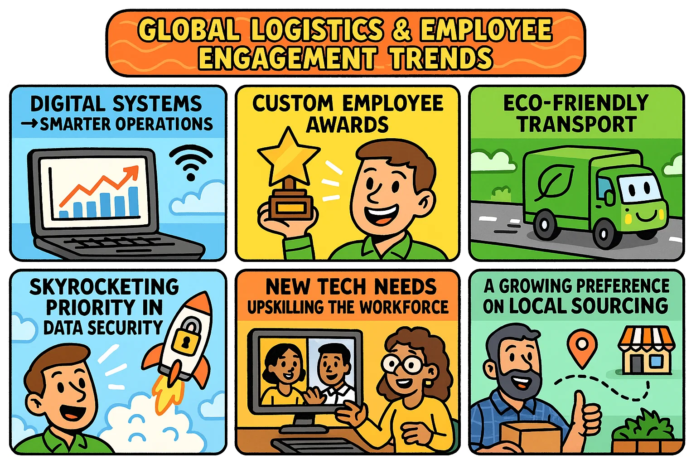
Changing tech, green initiatives, and shifting work habits reshape logistics everywhere.
Most teams now want more than pay; purpose and recognition keep people around. Company leaders chase both profit and staff well-being in new ways this year.
You will see how these seven trends impact daily decisions for businesses worldwide.
Curious about what’s driving real change? Read on.
1. Digital Systems Power Smarter Operations
Automation is streamlining workflows. Thanks to digital systems, real-time tracking and predictive analytics enable faster decisions on shipping routes and inventory needs. Employees find repetitive tasks reduced as platforms handle data entry or stock updates automatically.
With easier communication across time zones, teams stay connected. Growing digitization means less manual labor, more focus on strategic work, and higher engagement for those adapting alongside the technology revolution in logistics.
2. Personalized Employee Recognition
One of the best ways to keep employees loyal and motivated is through thoughtful, tailored rewards. Companies see strong retention when team members feel noticed in meaningful ways, not just with a generic plaque.
Interest in personalized awards keeps rising, as organizations turn ceremonies into moments that reflect each person’s contribution. Platforms like Awards offer custom solutions such as engraved trophies and curated recognition experiences—fast becoming an HR trend that signals real appreciation and value.
3. Eco-Friendly Transport Gains Momentum
Sustainability now shapes logistics choices at every step. Electric vehicles, smarter route planning, and carbon offset programs shrink the industry’s footprint. Green shipping is no longer a side project but a key factor in attracting clients and talent alike, especially as environmental values guide more career and business decisions today.
4. Remote Collaboration Changing Supply Chains
In what’s now a global village, distance rarely gets in the way of progress. Digital platforms bring together teams across continents for real-time problem-solving and quick feedback.
This shift puts new pressures on logistics globally, not just because virtual coordination means supply chain disruptions can be resolved faster. It also requires strong digital skills from every worker involved.
5. Data Security Rises as a Top Priority
Every day, supply chains deal with sensitive information. It needs protecting from cyber threats and data leaks that could cripple operations or damage trust.
To safeguard everything from order details to payment records, companies now invest in:
- Better encryption,
- Access controls,
- And employee training programs.
That’s while still allowing quick access for those who need it most.
6. Upskilling the Workforce for New Tech
Did we mention training? Modern logistics relies on teams skilled in areas like:
- Data analysis,
- ERP systems,
- And warehouse management software.
Companies push hands-on workshops. They advocate for certification courses and mentorships so staff stay current.
The demand for digital know-how means employees who upskill are not just more productive but also set themselves up for bigger career opportunities ahead.
7. Local Sourcing Reshaping Global Routes
Regional suppliers now play a much bigger role as companies shorten delivery distances. This shift improves speed and reliability, as well as transparency while also reducing supply chain carbon emissions.
For manufacturers, responding to demand becomes faster. Cutting transport risks too.
Local sourcing also supports community economies. It helps businesses meet new rules on ethical production and sustainability reporting.
Endnote:
Shifts in logistics and employee engagement keep shaping how companies operate. Organizations that adapt to these shifts get an edge, from smarter operations to happier teams. And, attention to both technology and people lays the groundwork for lasting progress.





